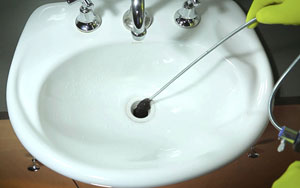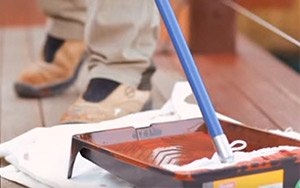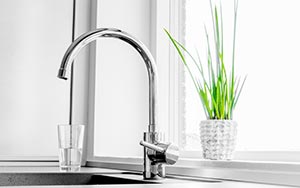Repainting a Peeling Surface
Scrape away flakes and smooth edges with sandpaper. Use an electric hot air stripper or chemical paint stripper to soften old paint making it easier to remove with a blade. Then sand, wash down with sugar soap and touch up bare areas with an undercoat or primer before painting.
Sealing Cracks
Force white cellulose filler mix into crack or hole and smooth over with a putty knife or damp cloth. When dry, smooth with medium-fine sandpaper. Fill larger holes in stages, allowing a few hours drying between applications.
Paint Brush Care
After painting with oil based paint, clean brushes in turps. For water based paints use warm soapy water only. Hang brush bristles down to dry. Always clear remaining solvent from the bristles by twirling the brush before re-using.
Paint Roller Techniques
Wash roller in paint solvent and roll out dust and particles. Load roller with paint and test roll a small area before you start. Use roller in a WW shape around one metre square and finish off with a vertical down stroke with light pressure for a smooth finish.
Applying Sealants
Clean and dry the area before applying sealant in a continuous and steady flow. Push Sealant ahead of nozzle, contacting both sides of the joint. Add masking tape to give a neat line and remove immediately after finishing. For improved appearance smooth over with a spatula.
Painting Roofs and Metal Surfaces
Disconnect down pipes from your water tank before starting. Then water blast roof and wire brush any rusted areas to remove debris. Apply rust neutralisers and fill holes with epoxy resin filler. Paint rusted areas with Metal Primer and finish with two coats of Roof Paint.
Hanging Wallpaper
For difficult areas like doors and windows hang the paper so that it overlaps. Gently run down the side of the architrave with the blunt part of the scissors and cut along the line. Smooth back onto wall, pressing the edge of the paper into the angle of the wall and architrave.
Hints on Using Abrasives
Don’t use coarser than you need and always test your job before you start. When moving from coarse to fine sandpaper, double the grit number for each successive stage, until the desired degree of finish is reached. And remember, straight line sanding with the grain scratches least.
Painting Professionally
Only dip half of the bristles into paint before tapping gently against both sides of the tin to remove excess. Use a criss-crossing stroke to spread paint evenly and start from the unpainted area, working back into the painted area, always maintaining a wet edge to avoid lap marks.
Removing Paint Stains
Nail polish remover will remove paint spatters on windows. Old stains can be softened with turpentine or linseed oil then scraped off with a razor blade. Steel wool dipped in hot vinegar or liquid cleanser removes fresh paint stains. Use baby oil to remove paint from hands and face.
Painting Techniques
“Cutting –In” is the term tradesman use for getting a neat join where paints of different colours meet. To achieve this effect on window frames and panel doors, load the brush lightly so you don’t cut into the edge of the glass, but allow a thick strip of paint about 3mm wide to protect the putty.
Spray Painting
For a professional finish keep the sprayer upright and spray parallel to the painting surface. Move the sprayer slowly and steadily using the entire arm to maintain uniform spacing between sprayer and surface. Start with a fine mist from a distance then work a little closer to the finish. Several light coats are best to ensure paint doesn’t run.
Painting a Deck
If the deck is one of the hard, durable timbers like batu or merbau it can probably be left to weather naturally. Remember though, most timbers will eventually change to a silver grey colour. There are a number of excellent finishes available. Timber gloss and low sheen acrylics are ideal for these areas.
Painting Taping Tips
Avoid stretching tape and pull off foil up to half a metre at a time, press down a small area, unwind the same distance again, press that down and continue. Lay tape into surface depressions and press edges down firmly to prevent leakage.




